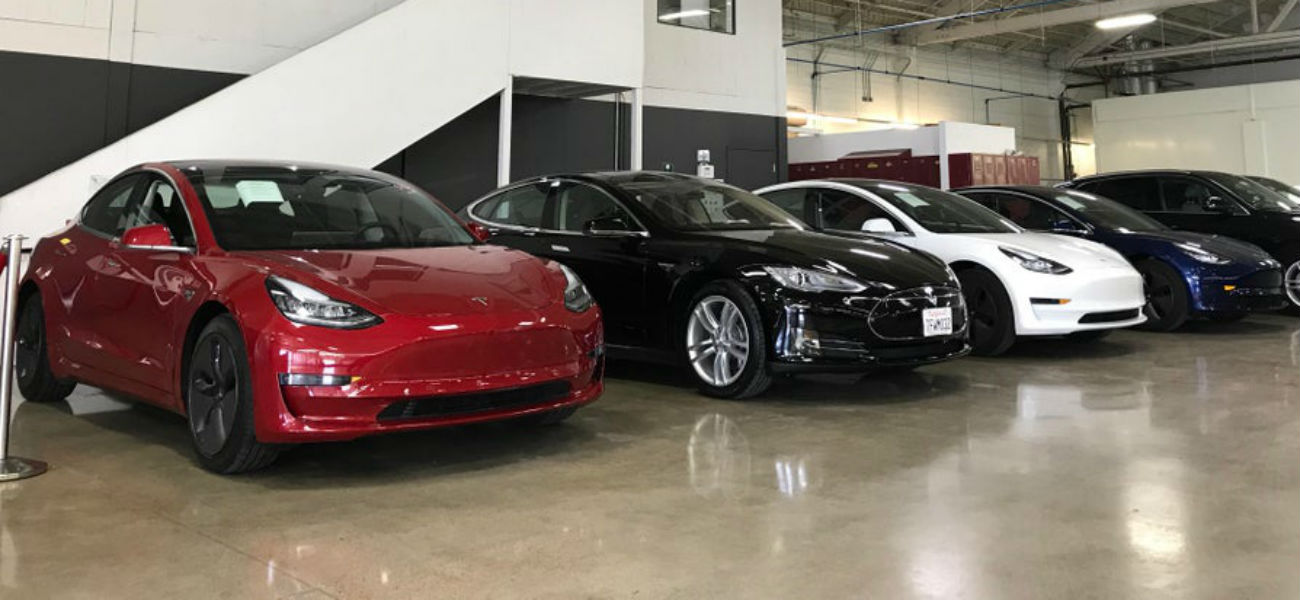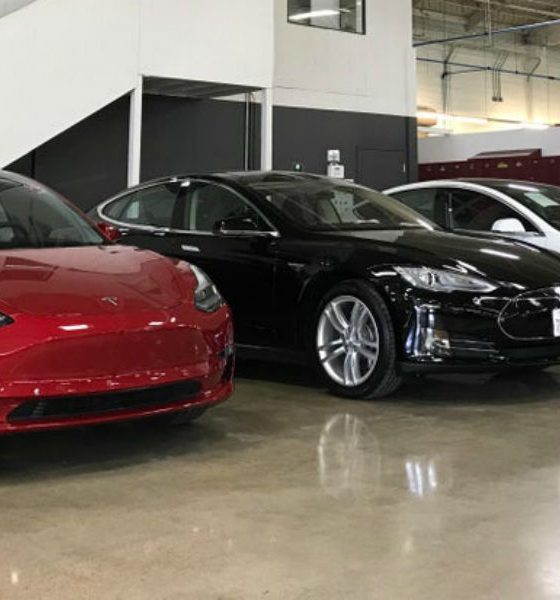

News
Tesla’s spare parts supply is reportedly nearing parity with German automakers
A firsthand account from a Tesla-certified body shop has suggested that the electric car maker recently adopted optimizations to its spare parts ordering and supply systems. These improvements have reportedly become significant enough to the point where Tesla is starting to close in on German automakers when it comes to the turnaround times of its parts ordering and receiving processes.
The new insights on Tesla’s parts supply were recently shared on the r/TeslaMotors subreddit by u/andoman66, who works for European Collision Center, a recently-certified body shop at the San Francisco Bay Area known for servicing German-made automobiles. Prior to the shop’s certification, the Tesla community member noted that the electric car maker’s parts ordering and receiving process were less than stellar. At times, for example, the shop ended up hand-delivering orders and manually picking up the parts from Tesla, resulting in long turnaround times for repairs.
These processes have been greatly improved recently. According to the body shop employee, Tesla has rolled out a wholesale ordering system that allows parts to get drop-shipped at a comparable turnaround time as premier German automakers. While Tesla’s current parts delivery times are still longer than those of its Japanese counterparts, the electric car maker’s efficiency has reportedly reached parity with Porsche and Audi, and is steadily catching up to Mercedes-Benz.
Apart from the welcome updates on the company’s parts and delivery processes, the electric car maker reportedly requires collision repair facilities to offer labor discounts to Tesla owners as part of the shop’s certification. This, according to the body shop employee, is something that is quite unique to Tesla. Together with a more efficient supply system, these processes would likely make the repair experience of Tesla owners more manageable than before.
Elon Musk has personally pledged to address Tesla’s service and repair challenges, even stating that the company is aiming to eventually achieve 24-hour turnaround times for vehicle repairs. Tesla has also introduced recent firmware updates focused on optimizing its electric cars’ repair process. Just last month, for example, Tesla rolled out an update that allowed vehicles to proactively order and pre-ship replacement parts. With such a system in place, Tesla owners could simply use their mobile app or their Tesla account to schedule a service visit.
With the company’s fleet of vehicles rapidly growing due to the arrival of the Model 3, Tesla has also begun an expansion of its service capacity. During the Q4 2018 earnings call, for example, Elon Musk noted that the company is looking to double its service capacity this 2019. The electric car maker is also aiming to expand its mobile service fleet, which Musk states is already capable of addressing around 80% of repairs needed for Tesla’s electric cars. Currently, Tesla is utilizing vans and modified Model S as its mobile service units, though recent reports are pointing to the company also using the Model X for bigger repair tasks.
H/T to u/andoman66 of the r/TeslaMotors subreddit.

News
Tesla FSD fleet is nearing 7 billion total miles, including 2.5 billion city miles
As can be seen on Tesla’s official FSD webpage, vehicles equipped with the system have now navigated over 6.99 billion miles.

Tesla’s Full Self-Driving (Supervised) fleet is closing in on almost 7 billion total miles driven, as per data posted by the company on its official FSD webpage.
These figures hint at the massive scale of data fueling Tesla’s rapid FSD improvements, which have been quite notable as of late.
FSD mileage milestones
As can be seen on Tesla’s official FSD webpage, vehicles equipped with the system have now navigated over 6.99 billion miles. Tesla owner and avid FSD tester Whole Mars Catalog also shared a screenshot indicating that from the nearly 7 billion miles traveled by the FSD fleet, more than 2.5 billion miles were driven inside cities.
City miles are particularly valuable for complex urban scenarios like unprotected turns, pedestrian interactions, and traffic lights. This is also the difference-maker for FSD, as only complex solutions, such as Waymo’s self-driving taxis, operate similarly on inner-city streets. And even then, incidents such as the San Francisco blackouts have proven challenging for sensor-rich vehicles like Waymos.
Tesla’s data edge
Tesla has a number of advantages in the autonomous vehicle sector, one of which is the size of its fleet and the number of vehicles training FSD on real-world roads. Tesla’s nearly 7 billion FSD miles then allow the company to roll out updates that make its vehicles behave like they are being driven by experienced drivers, even if they are operating on their own.
So notable are Tesla’s improvements to FSD that NVIDIA Director of Robotics Jim Fan, after experiencing FSD v14, noted that the system is the first AI that passes what he described as a “Physical Turing Test.”
“Despite knowing exactly how robot learning works, I still find it magical watching the steering wheel turn by itself. First it feels surreal, next it becomes routine. Then, like the smartphone, taking it away actively hurts. This is how humanity gets rewired and glued to god-like technologies,” Fan wrote in a post on X.
News
Tesla starts showing how FSD will change lives in Europe
Local officials tested the system on narrow country roads and were impressed by FSD’s smooth, human-like driving, with some calling the service a game-changer for everyday life in areas that are far from urban centers.

Tesla has launched Europe’s first public shuttle service using Full Self-Driving (Supervised) in the rural Eifelkreis Bitburg-Prüm region of Germany, demonstrating how the technology can restore independence and mobility for people who struggle with limited transport options.
Local officials tested the system on narrow country roads and were impressed by FSD’s smooth, human-like driving, with some calling the service a game-changer for everyday life in areas that are far from urban centers.
Officials see real impact on rural residents
Arzfeld Mayor Johannes Kuhl and District Administrator Andreas Kruppert personally tested the Tesla shuttle service. This allowed them to see just how well FSD navigated winding lanes and rural roads confidently. Kruppert said, “Autonomous driving sounds like science fiction to many, but we simply see here that it works totally well in rural regions too.” Kuhl, for his part, also noted that FSD “feels like a very experienced driver.”
The pilot complements the area’s “Citizen Bus” program, which provides on-demand rides for elderly residents who can no longer drive themselves. Tesla Europe shared a video of a demonstration of the service, highlighting how FSD gives people their freedom back, even in places where public transport is not as prevalent.
What the Ministry for Economic Affairs and Transport says
Rhineland-Palatinate’s Minister Daniela Schmitt supported the project, praising the collaboration that made this “first of its kind in Europe” possible. As per the ministry, the rural rollout for the service shows FSD’s potential beyond major cities, and it delivers tangible benefits like grocery runs, doctor visits, and social connections for isolated residents.
“Reliable and flexible mobility is especially vital in rural areas. With the launch of a shuttle service using self-driving vehicles (FSD supervised) by Tesla in the Eifelkreis Bitburg-Prüm, an innovative pilot project is now getting underway that complements local community bus services. It is the first project of its kind in Europe.
“The result is a real gain for rural mobility: greater accessibility, more flexibility and tangible benefits for everyday life. A strong signal for innovation, cooperation and future-oriented mobility beyond urban centers,” the ministry wrote in a LinkedIn post.
News
Tesla China quietly posts Robotaxi-related job listing
Tesla China is currently seeking a Low Voltage Electrical Engineer to work on circuit board design for the company’s autonomous vehicles.

Tesla has posted a new job listing in Shanghai explicitly tied to its Robotaxi program, fueling speculation that the company is preparing to launch its dedicated autonomous ride-hailing service in China.
As noted in the listing, Tesla China is currently seeking a Low Voltage Electrical Engineer to work on circuit board design for the company’s autonomous vehicles.
Robotaxi-specific role
The listing, which was shared on social media platform X by industry watcher @tslaming, suggested that Tesla China is looking to fill the role urgently. The job listing itself specifically mentions that the person hired for the role will be working on the Low Voltage Hardware team, which would design the circuit boards that would serve as the nervous system of the Robotaxi.
Key tasks for the role, as indicated in the job listing, include collaboration with PCB layout, firmware, mechanical, program management, and validation teams, among other responsibilities. The role is based in Shanghai.
China Robotaxi launch
China represents a massive potential market for robotaxis, with its dense urban centers and supportive policies in select cities. Tesla has limited permission to roll out FSD in the country, though despite this, its vehicles have been hailed as among the best in the market when it comes to autonomous features. So far, at least, it appears that China supports Tesla’s FSD and Robotaxi rollout.
This was hinted at in November, when Tesla brought the Cybercab to the 8th China International Import Expo (CIIE) in Shanghai, marking the first time that the autonomous two-seater was brought to the Asia-Pacific region. The vehicle, despite not having a release date in China, received a significant amount of interest among the event’s attendees.








